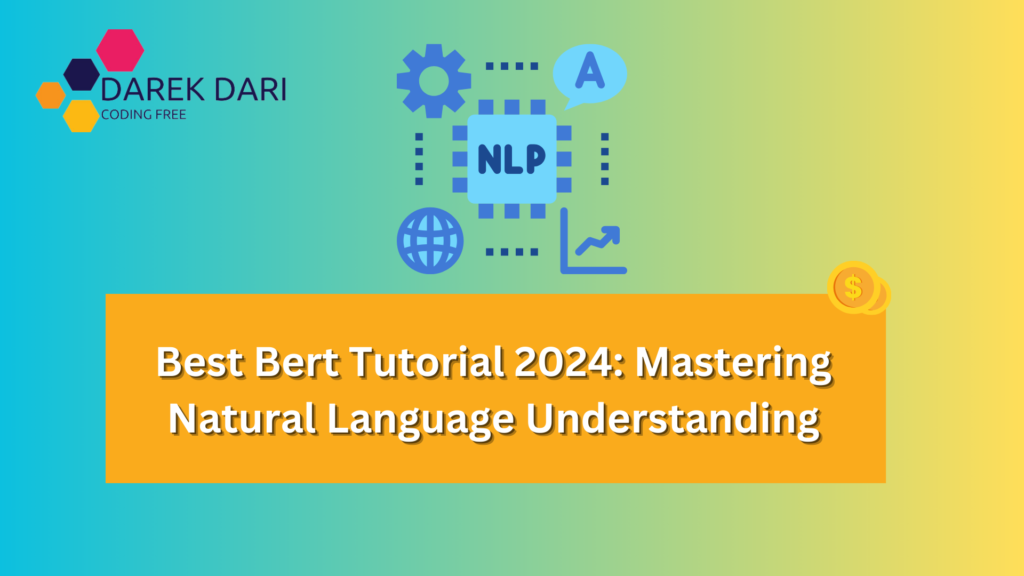
Table of Contents
Introduction
BERT is a game-changer in the field of natural language processing (NLP). As an abbreviation for Bidirectional Encoder Representations from Transformers, BERT has completely changed the way machines understand human language.
It has paved the way for significant progress in areas such as sentiment analysis, question answering, and language translation.
Join us in this detailed tutorial on BERT as we explore its inner workings, providing useful tips and code examples throughout the journey.
What is BERT?
BERT, introduced by Google in 2018, represents a paradigm shift in NLP. Unlike previous models that processed words in isolation, BERT considers the entire context of a sentence by leveraging bidirectional attention mechanisms.
import torch
from transformers import BertModel, BertTokenizer
tokenizer = BertTokenizer.from_pretrained('bert-base-uncased')
model = BertModel.from_pretrained('bert-base-uncased')Understand BERT Architecture
To wield BERT effectively, one must grasp its intricate architecture.
BERT Architecture Explained
BERT comprises multiple layers of Transformer encoders, each responsible for capturing different levels of contextual information.
# BERT model architecture
print(model)Transformer Encoders: The Heart of BERT
Transformer encoders process input tokens in parallel, allowing BERT to capture bidirectional context efficiently.
# Transformer encoder layer
from transformers import BertConfig, BertModel
config = BertConfig()
encoder = BertModel(config)Training BERT Models
Training BERT models requires massive computational resources and large-scale datasets.
Pretraining BERT
BERT undergoes pretraining on vast corpora to learn general language representations.
# Pretraining BERT
from transformers import BertForPreTraining
model = BertForPreTraining.from_pretrained('bert-base-uncased')Fine-Tuning BERT
Fine-tuning BERT involves adapting pretrained models to specific downstream tasks, such as sentiment analysis or named entity recognition.
# Fine-tuning BERT
from transformers import BertForSequenceClassification
model = BertForSequenceClassification.from_pretrained('bert-base-uncased')Applying BERT in NLP Tasks
The versatility of BERT extends to various NLP applications, where it consistently achieves state-of-the-art results.
Sentiment Analysis with BERT
Harnessing BERT for sentiment analysis entails fine-tuning pretrained models on sentiment-labeled datasets.
# Sentiment analysis with BERT
from transformers import BertForSequenceClassification
model = BertForSequenceClassification.from_pretrained('bert-base-uncased')Named Entity Recognition (NER) with BERT
BERT’s contextual understanding empowers NER systems to accurately identify entities in text.
# Named Entity Recognition with BERT
from transformers import BertForTokenClassification
model = BertForTokenClassification.from_pretrained('bert-base-uncased')BERT Steps
Tokenization
The first step in mastering BERT is tokenization. This process involves breaking down the input text into individual tokens, which can represent words, subwords, or characters depending on the tokenization strategy used. BERT’s tokenizer ensures that the model can effectively process the text at a detailed level.
Model Initialization
After tokenization, the next crucial step is initializing the BERT model. This includes loading pre-trained models that have learned contextual representations of language from vast amounts of text data.
Depending on your NLP task, you can either use a pre-trained model directly for inference or fine-tune it for your specific needs.
Input Encoding
Once the model is set up, the tokenized text must be encoded into a format that BERT can understand. This involves converting the tokens into numerical representations.
Special tokens like [CLS] for classification and [SEP] for separation are added to provide context to the model.
Inference/Fine-Tuning
With the input properly encoded, you can now apply BERT to your NLP tasks through inference or fine-tuning.
Inference uses the pre-trained model to make predictions or extract features from the text. Fine-tuning involves further training the model on task-specific data to adapt its representations.
Evaluation
After using BERT for your NLP tasks, it’s crucial to evaluate its performance. Metrics like accuracy, precision, recall, and F1 score can help determine how well BERT is performing on specific tasks.
By evaluating the model, you can understand its effectiveness and make necessary adjustments.
What is BERT used for?
BERT, also known as Bidirectional Encoder Representations from Transformers, is a highly versatile and effective tool in the field of natural language processing (NLP).
It has proven its worth across a wide range of tasks, including text classification, named entity recognition (NER), question answering, and semantic similarity measurement.
When it comes to text classification, BERT excels at accurately categorizing text into predefined classes. This is crucial for tasks such as sentiment analysis, topic classification, and spam detection.
Additionally, BERT’s proficiency in NER allows it to precisely identify and classify named entities within text documents, which is essential for tasks like document summarization and information extraction.
One of BERT’s standout features is its contextual understanding, which enables it to excel in question answering tasks. By extracting relevant information from text passages, BERT can provide accurate responses in natural language.
Beyond its core applications, BERT also contributes significantly to text generation, language understanding, and summarization tasks. This solidifies its position as a foundational model in NLP.
Its ability to comprehend the intricacies of human language has revolutionized various industries, including healthcare and finance. It enables more accurate sentiment analysis, document summarization, and information retrieval.
In summary, BERT’s wide-ranging capabilities make it an indispensable tool for tackling the complex challenges of language processing in the digital age.
Is BERT better than GPT?
Comparing BERT and GPT is akin to comparing apples and oranges – they serve different purposes and excel in different domains of natural language processing (NLP).
| BERT | GPT | |
|---|---|---|
| Purpose | Understanding contextual relationships between words in a sentence. | Generating coherent and contextually relevant text continuations. |
| Tasks | Text classification, named entity recognition, question answering, semantic similarity measurement. | Language modeling, text completion, dialogue generation. |
| Approach | Captures bidirectional context within a sentence. | Predicts the next word in a sequence of text based on context. |
| Strengths | Excellent for tasks requiring understanding and classifying text. | Ideal for tasks involving text generation and completion. |
| Example Use Cases | Sentiment analysis, named entity recognition, question answering. | Language modeling, text completion, dialogue generation. |
So, who wins in this epic showdown? It all depends on the task at hand! Need to understand and classify text? BERT’s got your back! Looking to craft stories and complete sentences? GPT’s the hero of the hour!
In the world of NLP, it’s not about who’s better – it’s about choosing the right hero for the job. Whether you’re solving mysteries with BERT or spinning tales with GPT, both these linguistic superheroes are here to save the day and make the world of language a little more fun and exciting!
Is BERT a neural network?
You bet! BERT is totally a neural network, but think of it less like a robot overlord and more like your chatty friend who’s really good at understanding context.
Picture this: BERT’s brain is like a supercharged version of yours, but instead of just processing words one at a time, it’s like it’s got eyes in the back of its head, seeing the whole picture all at once!
So, yeah, BERT’s definitely a neural network, but it’s not the kind that’s going to take over the world – unless you count dominating the field of natural language processing (NLP)!
It’s more like your trusty sidekick, here to help you understand and process language in all its glorious complexity. So, next time you’re tackling a tough text or trying to make sense of a sentence, remember: BERT’s got your back, neural network style!
Is BERT a generative AI model?
BERT, short for Bidirectional Encoder Representations from Transformers, isn’t your typical generative AI model.
It functions more like the mastermind behind the scenes, using its powers to comprehend and analyze language rather than creating fresh content from scratch.
Although BERT is undeniably potent, its main focus lies in tasks such as grasping context, categorizing text, and extracting details from existing information.
Think of it as the clever investigator who connects the dots to unravel a mystery, rather than the imaginative writer who weaves magical stories out of nothing.
Nevertheless, BERT plays a vital role in natural language understanding and processing, paving the way for more creative AI models like GPT (Generative Pre-trained Transformer) that excel in generating new text.
So, even though BERT isn’t a generative AI model itself, it remains a crucial component of the AI landscape, laying the foundation for a variety of linguistic escapades!
Is BERT PyTorch or TensorFlow?
BERT is versatile! It comes in versions for both PyTorch and TensorFlow, catering to users of both popular deep learning frameworks.
Whether you’re a PyTorch fan or a TensorFlow supporter, you can leverage the power of BERT in your NLP projects.
It’s like having two different flavors of your favorite ice cream – you can pick between the creamy goodness of PyTorch or the robustness of TensorFlow, all while benefiting from the same amazing BERT model!
So, whether you’re working on advanced NLP applications in PyTorch or TensorFlow, BERT has got your back, making it simpler than ever to explore the fascinating realm of natural language processing.
Is BERT better than LSTM?
BERT and LSTM are two different neural network architectures used in natural language processing (NLP). While they both have their strengths, they excel in different areas.
BERT is particularly effective in tasks that involve understanding contextual relationships within text. It has the ability to capture bidirectional context, which means it can piece together clues from both past and future events to get a complete understanding of the story. This makes BERT well-suited for tasks like text classification, named entity recognition, and question answering.
On the other hand, LSTM is a type of recurrent neural network (RNN) that is great for processing sequential data, including text data. It acts as a reliable sidekick that remembers important details from the past and uses them to make predictions about the future. LSTM is commonly used in tasks like language modeling, speech recognition, and time series prediction.
The choice between BERT and LSTM depends on the specific task at hand. If the task requires understanding context and relationships within text, BERT may be the preferred choice. On the other hand, if the task involves sequential data processing and memory retention, LSTM could be the better option.
In conclusion, both BERT and LSTM are valuable tools in the NLP toolbox, each with its own strengths and applications. The key is to choose the right tool for the job based on the specific requirements of the task.
Is BERT outdated?
Absolutely not! BERT, also known as Bidirectional Encoder Representations from Transformers, is still at the forefront of natural language processing (NLP). Its impact is felt across various industries and research domains.
Since its introduction, BERT has become a fundamental component of NLP, completely transforming how we approach tasks like text classification, named entity recognition, question answering, and more. Its remarkable ability to understand and process language by capturing bidirectional context within text has made it incredibly effective.
Although newer models and architectures have emerged since BERT’s release, it remains widely used and highly respected within the NLP community. Researchers and practitioners continue to rely on BERT as a benchmark model for evaluating new approaches and addressing a wide range of NLP challenges.
Furthermore, advancements in model architectures and training techniques have led to the development of variations and improvements upon the original BERT model. Models like RoBERTa, ALBERT, and DistilBERT offer enhancements in terms of efficiency, performance, and scalability.
Far from being outdated, BERT remains a foundational model in NLP, driving innovation and breakthroughs in language understanding and processing. As the field of NLP continues to evolve, BERT and its derivatives will undoubtedly play a significant role in shaping the future of language technology.
Is Google BERT free?
Certainly! BERT is an open-source model that is freely available for anyone to use. Google has made the original BERT model, along with its pre-trained weights and code, accessible through the TensorFlow models repository. This allows researchers, developers, and practitioners to take advantage of its capabilities for various natural language processing (NLP) tasks.
You can download and use the pre-trained BERT models, which enables you to fine-tune them on your own datasets for specific NLP tasks or directly perform inference on text inputs. Moreover, BERT has been implemented in other deep learning frameworks like PyTorch, making it accessible to a wider community of developers.
While BERT itself is free to use, it’s important to keep in mind that training custom BERT models or fine-tuning existing ones may require substantial computational resources, such as powerful GPUs or TPUs, as well as large datasets for training. However, Google’s pre-trained BERT models can serve as a starting point for many NLP tasks without the need for extensive training resources.
Overall, BERT’s open-source nature has democratized access to cutting-edge NLP technology, empowering researchers and developers worldwide to build upon its capabilities and drive advancements in the field of natural language processing.
Is BERT better than spaCy?
- BERT and spaCy have distinct purposes and excel in different areas of natural language processing (NLP), so it’s not accurate to claim that one is inherently superior to the other. Let’s delve into their variances:
BERT (Bidirectional Encoder Representations from Transformers) is a deep learning model crafted for grasping the contextual relationships within text. It shines in tasks like text classification, named entity recognition, and question answering by effectively capturing bidirectional context. BERT is particularly adept at tasks that demand an understanding of language nuances and context.
On the flip side, spaCy is a Python library and framework tailored for NLP tasks. It offers a wide array of tools and functionalities for tasks such as tokenization, part-of-speech tagging, dependency parsing, and named entity recognition. spaCy is renowned for its efficiency, user-friendliness, and robustness, making it a favored choice for developers and researchers engaged in various NLP projects.
BERT is well-suited for tasks requiring a profound comprehension of language and context, while spaCy is a versatile library for a broad spectrum of NLP tasks with an emphasis on efficiency and user-friendliness. Depending on the specific needs of your project, you may opt to utilize BERT, spaCy, or even both in tandem to achieve optimal results. Ultimately, the “better” choice hinges on the specific requirements and objectives of your NLP project.
Is BERT an autoencoder?
No, BERT is not an autoencoder. BERT is built on the Transformer architecture, which includes encoder and decoder layers, but it does not work as a traditional autoencoder.
Autoencoders are neural networks used for unsupervised learning, where the network learns to reconstruct its input data. They have an encoder network that compresses data into a lower-dimensional representation and a decoder network that reconstructs the original input.
On the other hand, BERT is a pre-trained model for tasks like text classification and question answering. It is trained on large text datasets using a masked language model objective, where some input tokens are masked, and the model predicts them based on context.
Although both autoencoders and BERT learn input data representations, they have different purposes and principles. Autoencoders focus on compression and reconstruction, while BERT learns contextual language representations for NLP tasks.
FAQs About BERT
What makes BERT different from previous NLP models?
BERT’s bidirectional context understanding sets it apart, allowing it to capture deeper semantic meanings compared to earlier models.
Can BERT handle out-of-vocabulary words?
Yes, BERT utilizes subword tokenization to handle out-of-vocabulary words effectively.
How does BERT achieve contextual understanding?
BERT leverages self-attention mechanisms within Transformer encoders to weigh the importance of each input token based on its context.
Is BERT suitable for small-scale NLP tasks?
While BERT excels with large-scale datasets, techniques like distillation and pruning enable its deployment in resource-constrained environments.
Can BERT be fine-tuned for custom NLP tasks?
Absolutely, fine-tuning BERT on task-specific datasets enhances its performance across various NLP tasks.
How does BERT handle sentence-pair tasks?
BERT incorporates special token embeddings to distinguish between different segments in sentence-pair tasks, facilitating nuanced understanding.
Conclusion
In this definitive BERT tutorial, we’ve delved into the intricacies of Bidirectional Encoder Representations from Transformers.
Armed with a deeper understanding of BERT’s architecture, training procedures, and applications in NLP, you’re well-equipped to embark on your journey toward NLP mastery.
So, dive in, experiment with BERT, and unlock the full potential of natural language understanding in your projects.




0 Comments